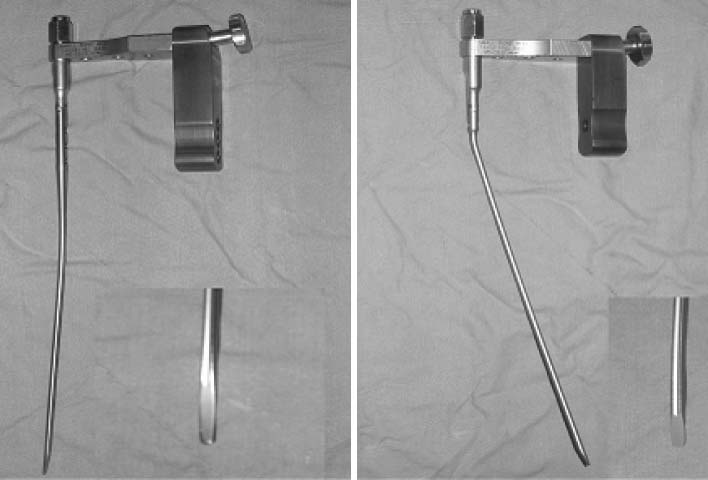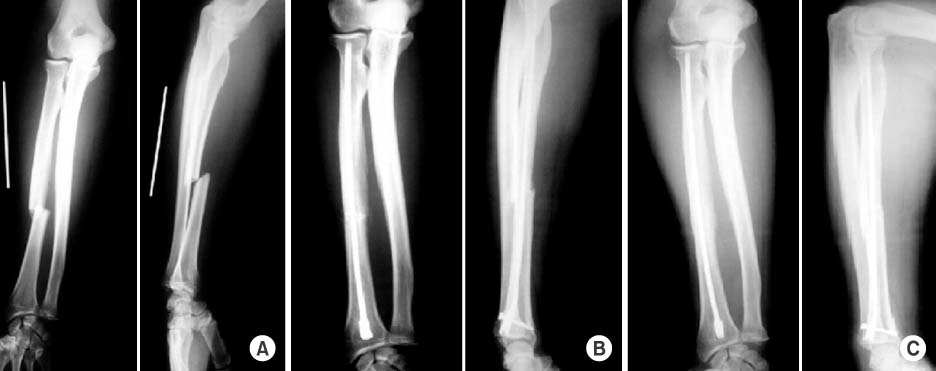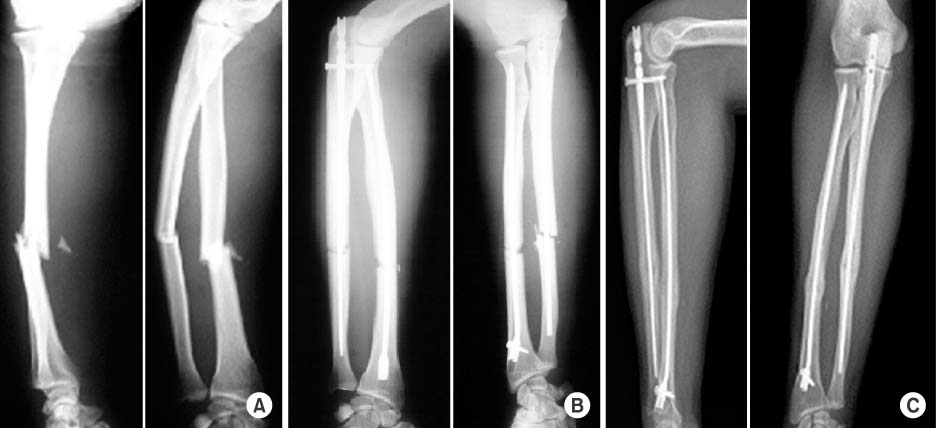Articles
- Page Path
- HOME > J Musculoskelet Trauma > Volume 21(2); 2008 > Article
-
Original Article
- Treatment of Forearm Shaft Fracture with Modified Interlocking Intramedullary Nail
- Kwang-Yul Kim, M.D., Moon-Sup Lim, M.D., Shin-Kwon Choi, M.D., Hyeong-Jo Yoon, M.D.
-
Journal of the Korean Fracture Society 2008;21(2):157-164.
DOI: https://doi.org/10.12671/jkfs.2008.21.2.157
Published online: April 30, 2008
Department of Orthopedic Surgery, Wallece Memorial Baptist Hospital, Busan, Korea.
- Address reprint requests to: Kwang-Yul Kim, M.D. Department of Orthopedic Surgery, Wallece Memorial Baptist Hospital, 374-75, Namsan-dong, Geumjeong-gu, Busan 609-728, Korea. Tel: 82-51-580-1422, Fax: 82-51-583-2568, kykimdr@yahoo.co.kr
Copyright © 2008 The Korean Fracture Society. All rights reserved.
This is an Open Access article distributed under the terms of the Creative Commons Attribution Non-Commercial License (http://creativecommons.org/licenses/by-nc/3.0/) which permits unrestricted non-commercial use, distribution, and reproduction in any medium, provided the original work is properly cited.
- 489 Views
- 0 Download
- 1 Crossref
Abstract
-
Purpose
- To evaluate the result of forearm shaft fracture treated by modified interlocking intramedullary nail (Acumed, Hillsbrough, IN, USA).
-
Materials and Methods
- 15 patients with fracture of radius, ulna, radio-ulna shaft treated by modified interlocking intramedullary nail from December 2003 to February 2007 were analyzed. Modified interlocking intramedullary nail has paddle blade tip and fluted rod, so the distal screw fixation was not needed but had relatively firm fixation. It has advantages including short operation time, small operation scar. The average follow up period was 8.3 months (range, 5~15 months). We analyzed the results by average union time and the functional results according to Anderson's criteria.
-
Results
- The mean duration of union was 9.8 weeks in radius and 11.4 weeks in ulna. The average range of motion of forearm was 74.6 degree in supination and 72 degree in pronation. Functional results assessed by Anderson were rated excellet in 12 cases, satisfactory in 3 cases. We found no complications such as delayed union, non-union, neurovascular injury and infection.
-
Conclusion
- Modified interlocking intramedullary nail (Acumed, Hillsbrough, IN, USA) is a viable therapeutic alternative in the management of forearm shaft fracture.
- 1. Anderson LD. Treatment of ununited fractures of the long bones; compression plate fixation and the effect of different types of internal fixation on fracture healing. J Bone Joint Surg Am, 1965;47:191-208.
- 2. Anderson LD, Sisk TD, Tooms RE, Park WI III. Compression plate fixation in acute diaphyseal fractures of the radius and ulna. J Bone Joint Surg Am, 1975;57:287-293.
- 3. Anderson LD, Sisk TD, Tooms RE, Park WI. Compression plate fixation in acute diaphyseal fractures of the radius and ulna. In proceeding Americal Academy of Orthopedic Surgerns. J Bone Joint Surg Am, 1972;54:1332-1333.
- 4. Burwell HN, Chanley AD. Treatment of forearm fractures in adults with particular referance to plate fixation. J Bone Joint Surg Br, 1964;46:404-425.
- 5. Choi CU, Rah SK, Choi WS, Song K, Kwon JW. A clinical result of the fracture of the forearm bone shaft in adult. J Korean Orthop Assoc, 1984;19:339-350.
- 6. Chung IH, Bae DK, Yoo MC, Kim BK. Compression plate fixation in the treatment of diaphyseal fractures of the radius and ulna. J Korean Orthop Assoc, 1980;15:43-50.
- 7. Cullen MC, Roy DR, Giza E, Crawford AH. Complications of intramedullary fixation of pediatric forearm fracture. J Pediatr Orthop, 1998;18:14-21.
- 8. Danis R. Theorie et pratique de l'osteosynthese. Paris: Masson et Cie; 1949. p. 95-105.
- 9. Daruwalla JS. A study of radioulnar movements following fractures of the forearm in children. Clin Orthop Relat Res, 1979;139:114-120.
- 10. DePalma AF. The management of fractures and dislocation. 2nd ed. Philadelphia: WB Saunders Co; 1970.
- 11. Dodge HS, Cardy GW. Treatment of fracture of radius and ulnar with compression plates. J Bone Joint Surg Am, 1972;54:1167-1176.
- 12. Dumont CE, Thalmann R, Macy JC. The effects of Rotational Maluion of the Radius and the Ulna on supination and pronation. J Bone Joint Surg Br, 2002;84:1070-1074.
- 13. Grace TG, Evermann WW Jr. Forearm fractures. Treatment by rigid fixation with early motion. J Bone Joint Surg Am, 1980;62:433-438.
- 14. Gustilo RB, Anderson JT. Prevention of infection in the treatment of one thousand and twenty-five open fractures of long bones. Retrospective and prospective analyses. J Bone Joint Surg Am, 1976;58:453-458.
- 15. Hong KP, Park BM, Chung IH. A clinical study on fracture of shaft of forearm bones. J Korean Orthop Assoc, 1980;15:51-60.
- 16. Hughston JC. Fracture of the forearm. J Bone Joint Surg Am, 1962;44:1664-1667.
- 17. Jinkins WJ Jr, Lockhart LD, Eggers GW. Fractures of the forearm in adults. Southern Med J, 1960;53:669-679.
- 18. Kaufer H, Sonstegard DA, Garver DF, Matthews . Quantification of the effect of angular malalignment of the forearm bones upon the range of pronation-supination. Trans Orthop Res Soc, 1977;2:134.
- 19. Kim JM, Kim I, Moon MS. Fractures of forearm bones. J Korean Orthop Assoc, 1972;7:283-292.
- 20. Kim JR, Song KJ, Jung JW, Lee JM, Hwang BY. Functional outcome after operative treatment of the fractures of the forearm both bones. J Korean Soc Fract, 1997;10:934-939.
- 21. Kim MH, Yoo MJ, Jung HG, et al. Treatement of diaphyseal fractures of forearm both bones: comparison between plate fixation and rush pin intramedullary nailing. J Korean Fract Soc, 2006;19:215-220.
- 22. Knight RA, Purvis GD. Fracture of both bone of the forearm in adults. J Bone Joint Surg Am, 1949;31:755-764.
- 23. Lane WA. Method of procedure in operation on simple fractures. Br Med J, 1912;2:1532.
- 24. Lascombes P, Prevot J, Ligier JN, Metaizeau JP, Poncelet T. Elastic stable intramedullary nailing in forearm shaft fractures in children: 85 cases. J Pediatr Orthop, 1990;10:167-171.
- 25. Muller ME, Allgower H, Schnerder R, Willengger H. Mannual of internal fixation. 2nd ed. Springer-Verlag Co; 1979. p. 182-187.
- 26. Richter D, Ostermann PA, Ekkernkamp A, Muhr G, Hahn MP. Elastic intramedullary nailing: a minimally invasive concept in the treatment of unstable forearm in children. J Pediatr Orthop, 1998;18:457-461.
- 27. Rockwood CA Jr, Green DP. Fractures of the shafts of the radius and ulna. 2nd ed. 1984.Vol. 1.
- 28. Rush LV, Rush HL. A technique for longitudinal pin fixation of certain fractures of the forearm. J Bone Joint Surg Am, 1939;21:619.
- 29. Sage FP. Medullary fixation of fracture of the forearm. A study of the medullary canal of the radius and a report of fifty fractures of the radius treated with a prevent triangular nail. J Bone Joint Surg Am, 1956;41:1489-1516.
- 30. Shim JI, Kim TS, Lee SJ, et al. Treatement of diaphyseal fractures of the forearm both bones. J Korean Soc Fract, 2000;13:1016-1023.
- 31. Shin HD, Rhee KJ, Yang JY, Yun SH, Lee MJ. Comparison of the clinical results between the plate fixation and intramedullary nailing for the diaphyseal both forearm bone fractures. J Korean Soc Fract, 1999;12:135-144.
- 32. Smith H, Sage FP. Medullary fixation of forearm fractures. J Bone Joint Surg Am, 1957;39:91-98.
- 33. Street DM. Intramedullary forearm nailing. Clin Orthop Relat Res, 1986;212:219-230.
- 34. Tynan MC, Fornalski S, McMahon PJ, Utkan A, Green SA, Lee TQ. The effects of ulnar axial malalignment on supination and pronation. J Bone Joint Surg Am, 2000;82:1726-1731.
- 35. Verstreken L, Delronge G, Lamoureux J. Shaft forearm fractures in children: intramedullary nailing with immediate motion: a preliminary report. J Pediatr Orthop, 1988;8:450-453.
REFERENCES
Fig. 1

Ulna rod and Radius rod made by Acumed. A targeted interlocking screw, a paddle blade tip design, fluted rod locks and rotationally secures bone segment.

Fig. 2
(B) Postoperative 2 yrs radiograph after fixation of ulnar with modified IM nail.
(C) Last follow up AP and lateral radiograph shows complete bone union after nail removal (post op 2 yrs).

(A) Forearm initial AP and lateral radiograph of 26-year-old woman shows ulnar shaft fracture after traffic accident.

Fig. 3
(B) Postoperative radiograph after fixation of radius with modified IM nail.
(C) 1 year after surgery.

(A) Radiographof 56-year-old man showing of radius shaft fracture after direct trauma.

Figure & Data
REFERENCES
Citations
Citations to this article as recorded by 

- Interlocking Intramedullary Nailing of Forearm Shaft Fractures in Adults
Sanglim Lee, Hee-Sung Lee, Yerl-Bo Sung, Jae-Kwang Yum
Journal of the Korean Fracture Society.2009; 22(1): 30. CrossRef
Treatment of Forearm Shaft Fracture with Modified Interlocking Intramedullary Nail




Fig. 1
Ulna rod and Radius rod made by Acumed. A targeted interlocking screw, a paddle blade tip design, fluted rod locks and rotationally secures bone segment.
Fig. 2
(A) Forearm initial AP and lateral radiograph of 26-year-old woman shows ulnar shaft fracture after traffic accident.
(B) Postoperative 2 yrs radiograph after fixation of ulnar with modified IM nail.
(C) Last follow up AP and lateral radiograph shows complete bone union after nail removal (post op 2 yrs).
Fig. 3
(A) Radiographof 56-year-old man showing of radius shaft fracture after direct trauma.
(B) Postoperative radiograph after fixation of radius with modified IM nail.
(C) 1 year after surgery.
Fig. 4
(A) Forearm initial Radiograph of 26-year-old man shows radio-ulnar shaft fracture after traffic accident.
(B) Postoperative AP and lateral radiograph. Both forearm bone were treated with modified IM nail.
(C) 18 months after surgery.
Fig. 1
Fig. 2
Fig. 3
Fig. 4
Treatment of Forearm Shaft Fracture with Modified Interlocking Intramedullary Nail
Functional result by Anderson
Summary of cases
*R: Radius, †U: Ulna, ‡S: Satisfactory, §E: Excellent.
Table 1
Functional result by Anderson
Table 2
Summary of cases
*R: Radius, †U: Ulna, ‡S: Satisfactory, §E: Excellent.

 E-submission
E-submission KOTA
KOTA TOTA
TOTA TOTS
TOTS



 Cite
Cite

